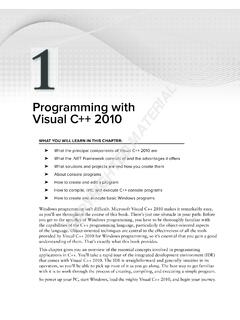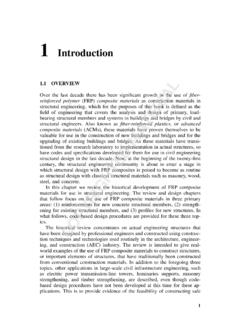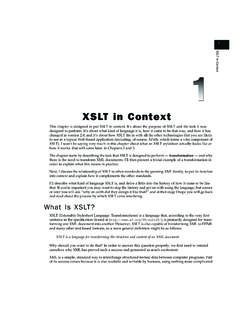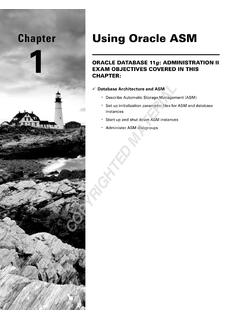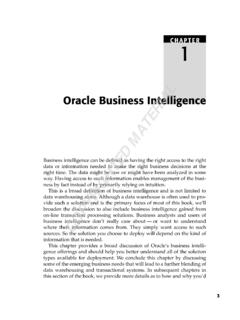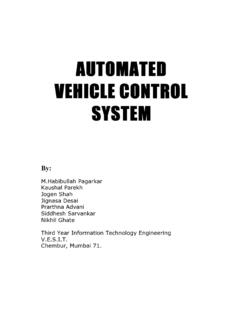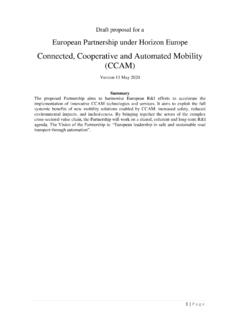Transcription of Key Concepts of Supply Chain Management
1 1 After reading this chapter you will be able to Appreciate what a Supply Chain is and what it does Understand where your company fits in the Supply chains itparticipates in and the role it plays in those Supply chains Discuss ways to align your Supply Chain with your businessstrategy Start an intelligent conversation about the Supply chainmanagement issues in your companyThis book is organized to give you a solid grounding in the nutsand bolts of Supply Chain Management . The book explains theessential Concepts and practices and then shows examples of howto put them to you finish you will have a solid foundation insupply Chain Management to work first three chapters give you a working understanding of thekey principles and business operations that drive any Supply Chain .
2 Thenext three chapters present the techniques, technologies, and metrics touse to improve your internal operations and coordinate more effective-ly with your customers and suppliers in the Supply chains your compa-ny is a part last three chapters show you how to find Supply Chain oppor-tunities and respond effectively to best capitalize on these 1 Key Concepts of Supply Chain 1/9/06 1:10 PM Page 1 COPYRIGHTED MATERIALCase studies are used to illustrate Supply Chain challenges and to presentsolutions for those challenges. These case studies and their solutionsbring together the material presented in the rest of the book and showhow it applies to real world business chains encompass the companies and the business activitiesneeded to design, make, deliver, and use a product or service.
3 Businessesdepend on their Supply chains to provide them with what they need tosurvive and thrive. Every business fits into one or more Supply chainsand has a role to play in each of pace of change and the uncertainty about how markets willevolve has made it increasingly important for companies to be aware of thesupply chains they participate in and to understand the roles that they companies that learn how to build and participate in strong supplychains will have a substantial competitive advantage in their Entirely New.. Just a Significant EvolutionThe practice of Supply Chain Management is guided by some basicunderlying Concepts that have not changed much over the hundred years ago, Napoleon made the remark, An armymarches on its stomach.
4 Napoleon was a master strategist and a skillfulgeneral and this remark shows that he clearly understood the impor-tance of what we would now call an efficient Supply Chain . Unless thesoldiers are fed, the army cannot these same lines, there is another saying that goes, Amateurstalk strategy and professionals talk logistics. People can discuss all sortsof grand strategies and dashing maneuvers but none of that will be pos-sible without first figuring out how to meet the day-to-day demands ofproviding an army with fuel, spare parts, food, shelter, and is the seemingly mundane activities of the quartermaster and the supplysergeants that often determine an army s success.
5 This has many analogiesin Supply Chain 1/9/06 1:10 PM Page 2 The term Supply Chain Management arose in the late 1980s andcame into widespread use in the 1990s. Prior to that time, businesses usedterms such as logistics and operations Management instead. Here aresome definitions of a Supply Chain : A Supply Chain is the alignment of firms that bring productsor services to market. from Lambert, Stock, and Ellram (Lambert, Douglas M., James R. Stock, and Lisa M. Ellram,1998,Fundamentals of Logistics Management , Boston, MA:Irwin/McGraw-Hill, Chapter 14). A Supply Chain consists of all stages involved, directly or indirectly, in fulfilling a customer request.
6 The Supply Chain notonly includes the manufacturer and suppliers, but also trans-porters, warehouses, retailers, and customers themselves .. from Chopra and Meindl (Chopra, Sunil, and Peter Meindl,2003, Supply Chain , Second Edition,Upper Saddle River, NJ:Prentice-Hall, Inc., Chapter 1). A Supply Chain is a network of facilities and distributionoptions that performs the functions of procurement ofmaterials, transformation of these materials into intermediateand finished products, and the distribution of these finishedproducts to customers. from Ganeshan and Harrison (Ganeshan, Ram, and Terry P.)
7 Harrison, 1995, AnIntroduction to Supply Chain Management , Department ofManagement Sciences and Information Systems, 303 BeamBusiness Building, Penn State University, University Park, PA).If this is what a Supply Chain is then we can define Supply Chain man-agement as the things we do to influence the behavior of the Supply chainand get the results we want. Some definitions of Supply Chain manage-ment are: The systemic, strategic coordination of the traditional busi-ness functions and the tactics across these business functionswithin a particular company and across businesses within thesupply Chain , for the purposes of improving the long-term per-3 Key Concepts of Supply Chain 1/9/06 1:10 PM Page 3formance of the individual companies and the Supply Chain asa whole.
8 From Mentzer, DeWitt, Keebler, Min, Nix, Smith,and Zacharia (Mentzer, John T.,William DeWitt, James , Soonhong Min, Nancy W. Nix, Carlo D. Smith, andZach G. Zacharia, 2001, Defining Supply ChainManagement, Journal of Business Logistics,Vol. 22, No. 2, p. 18). Supply Chain Management is the coordination of production,inventory, location, and transportation among the participantsin a Supply Chain to achieve the best mix of responsivenessand efficiency for the market being served. my own is a difference between the concept of Supply Chain manage-ment and the traditional concept of logistics.
9 Logistics typically refers toactivities that occur within the boundaries of a single organization andsupply chains refer to networks of companies that work together andcoordinate their actions to deliver a product to market. Also, traditionallogistics focuses its attention on activities such as procurement, distribution,maintenance, and inventory Management . Supply Chain managementacknowledges all of traditional logistics and also includes activities such asmarketing, new product development, finance, and customer the wider view of Supply Chain thinking, these additional activitiesare now seen as part of the work needed to fulfill customer Chain Management views the Supply Chain and the organizationsin it as a single entity.
10 It brings a systems approach to understanding andmanaging the different activities needed to coordinate the flow of productsand services to best serve the ultimate customer. This systems approachprovides the framework in which to best respond to business require-ments that otherwise would seem to be in conflict with each individually, different Supply Chain requirements often haveconflicting needs. For instance, the requirement of maintaining high levelsof customer service calls for maintaining high levels of inventory, but thenthe requirement to operate efficiently calls for reducing inventory levels.
